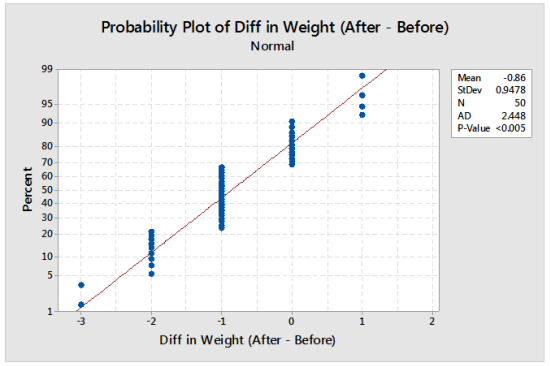

So different normally distributed data follow their respective best fit lines.Īgain, the lines bracketing the data and prediction lines are 95% confidence intervals on the prediction percentiles. Similarly, the $-N(5,1)-$ data, marked with red squares, follows the red dashed best fit line. The $-N(10,4)-$ data, marked with black circles, follows the black solid best fit line. The plot shows the two samples are normally distributed. The Minitab graphics include a probability plot, and key labeling and statistics in the upper right. A Minitab normal probability plot is shown in Figure 4. They are drawn from populations that are $-N(10,4)-$ and $-N(5,1)-$. These sample parameter estimates differ from the population parameters because of sampling variation.Ĭonsider two larger data sets with 100 values each. The data was drawn from the normal population $-N(10,1)-$. Visually, one can see the best fit line crosses the 50% grid line close to 10.4. All cumulative normal distributions display a straight line when plotted on normal paper.įrom the data, the sample mean is calculated with equation 1 and sample standard deviation is calculated with equation 2. The $-\sigma-$’s control the slopes of each line. The $-\mu-$’s control where each distribution line crosses the 50% grid line. The cumulative normal for each is plotted, figure 2, and both display as straight lines. Recognized that these parameters are generally unknown.Ĭonsider the two normal distributions, $-N(10,4)-$ and $-N(5,1)-$. For the normal, the parameters are the mean $-\mu-$ and the variance $-\sigma^2-$. Distribution parameters are provided within the parenthesis. L would be used for a lognormal distribution W, a Weibull and E, an Exponential. Here, the leading character N indicates the normal distribution. Sometimes the y-axis is marked with decimal values rather than percent.Ī statistical notation for describing a normal distribution is $-N(\mu,\sigma^2)-$.
#Normal probability plot minitab software
If computer software is used, the y-axis range can be any values greater than 0% and less than 100%. The range 1% to 99% is commonly frequently found. Other normal papers may span a different range. In figure 1, the scale is unique to the normal distribution. The y-axis is a non-linear cumulative probability scale. The number of intervals and tick mark labels should be selected to create an easily read scale. The x-axis range should span the data being analyzed. Normal paper designs are available with a different number of intervals. In figure 1, the x-axis is divided into 10 major intervals, each divided into 5 sub-intervals. Other probability papers and plots will be covered in future articles.Ĭonsider this normal probability paper from, figure 1.Īll normal paper have a linear x-axis. These probability papers designs are specific to a distribution type. Probability paper is available for many distributions, including the normal, lognormal, Weibull, and exponential. The analysis proceeds using the normal distribution and a wealth of statistical methods can be used. Then, the data is said to follow a normal distribution. This captures the idea that the human mind is good at discerning patterns.Īssume the data is plotted on normal probability paper and shows a linear trend. The old adage, “A picture is worth a thousand words”. But, how can this normal assumption be verified? While there are numerical normality tests, an alternate approach is to use graphical methods. When analyzing a continuous variable or type of measurement using statistics, an analyst often assumes data is normally distributed. Root Cause Analysis and the 8D Corrective Action Process course.An Introduction to Reliability Engineering.Reliability Analysis Methods online course.



 0 kommentar(er)
0 kommentar(er)
